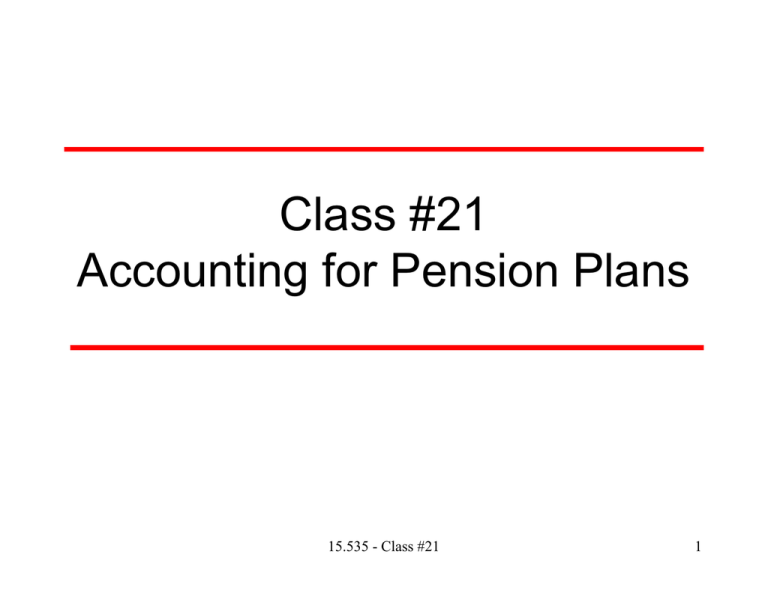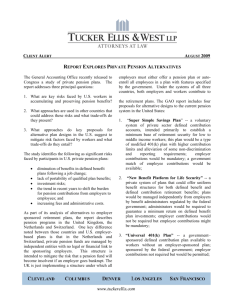Document 10289792
advertisement

Class #21 Accounting for Pension Plans 15.535 - Class #21 1 Announcements • Today’s Class - Readings: – Course Reader: Section K “Valuation of Firms with Pension Plans and Other Post Retirement Benefits” – Pages 349-364. • Assignment #3 due Thursday, May 8. 15.535 - Class #21 in class on 2 Pension Plans and Other Post- Employment Benefits: What and Why • Firms establish retirement pension plans to attract and retain quality employees. – Part of compensation package • Two Main Types of Plans: – Defined Contribution Plan – Defined Benefit Plan 15.535 - Class #21 3 Defined Contribution Plan (401K) • Defines amount employer contributes each year to employee’s pension account. – % of employee wages or firm net income (ie Walmart) • Contributions invested in pension plan (401-K) – No specification of benefits – Employees own the assets, but also bear the risk! – Amounts are often portable • Upon retirement, benefit payments to employee is based on value of accumulated contributions. • Defined contribution plans present no accounting problems for firms: – Contribution is expensed each year (GAAP & IRS). 15.535 - Class #21 4 Defined Benefit Plan • Define the employee’s benefit upon retirement. • Benefit formula often based on fixed % of ending salary for each year of service. • Uses PV to determine today’s contributions to support promised future benefits. – Employer needs to make a prediction of the future benefits to determine contribution = Projected benefit obligation • Employer bears investment risk in the plan 15.535 - Class #21 5 Defined Benefit Plan • Actuaries provide estimates of current pension expense and liability: – Age, sex, service years, salary & employee life span – Anticipated salary increase – Anticipated employee turnover rates – Anticipated earnings rate on plan assets – Appropriate discount rate for PV calculations • All estimates – involves discretion (important) 15.535 - Class #21 6 Defined Benefit Plan: Other Features • Implications of Defined Benefit Plans: – Incentives for employees to stay with firm until retirement (issue of vesting). – Incentives for employees to perform well to get the last raise to increase the defined benefit. From IBM Annual Report (Footnotes) “U.S. regular, full-time and part-time employees are covered by a noncontributory plan that is funded by company contributions to an irrevocable trust fund, which is held for the sole benefit of employees. Under a new formula, which is being phased in over five years, retirement benefits will be determined based on points accumulated for each year worked and final average compensation period. Benefits become vested upon the completion of five years of service.” 15.535 - Class #21 7 Defined Benefit Plans: Other Issues • If plan is underfunded, employees may lose earned benefits if the company goes bankrupt. – The Employees Retirement Income Security Act (ERISA) of 1974, requires firms to contribute a minimum of the service cost each year unless the plan is overfunded at the beginning of the year. – Tax incentives to fund pension plan - only the actual amounts contributed each year are tax deductible. • Funding incentives: – – – – Tax Financial Labor Contracting 15.535 - Class #21 8 Calculating the funding status of a pension plans • Funded Status: Difference between plan assets (PA) and Projected Benefit Obligation (PBO) – Overfunded when PA>PBO • Asset to the firms? – Underfunded when PA<PBO • Liability to the firm? • Where do we get this information? – In financial statement footnotes – Example: PepsiCo 2001 15.535 - Class #21 9 What changes funded status? • Yearly change in Plan Assets (PA): – Return on plan assets – Contributions by employer – Benefits paid to retirees • Change (PBO): in Projected Benefit Obligation – Service cost – Interest cost – Benefits paid – Plan amendments – Actuarial gains and losses 15.535 - Class #21 10 Funded status: What is reported on Balance Sheet? • The true funded status is not what is reported a firm’s consolidated balance sheet! – Make sure you look at footnotes (PepsiCo example) • Certain changes in funded status are smoother under GAAP rules (not recognized immediately) • Changes in pension plan assumptions and contribution levels from year-to-year can allow firm to also manage earnings. 15.535 - Class #21 11 Implication of funded status for financial analysis • Defined benefit pension plans can lead to hidden assets and (especially) hidden liabilities • Information in footnotes can be used to determine some of the hidden components: – See PepsiCo example • Problems are even more pronounced for international firms – Accounting for Pension Plans is even more opaque in other countries – Firms in other countries rely more on Defined Benefit Plans (versus Defined Contribution Plans) 15.535 - Class #21 12 Summary of Pension Accounting • Major Impact: Defined Contribution Plans • Potential for Large Unreported Pension Assets and Liabilities • Accounting for Defined Benefit Plans can result in Earnings Manipulation • Particularly important – Older firms (carryover Defined Benefit Plans) – Firms with large plans (ie General Motors) – Non-U.S. firms using different accounting rules 15.535 - Class #21 13 Next Class • International Financial Reporting and Analysis • Assignment #3 due on class next Thursday. 15.535 - Class #21 14







